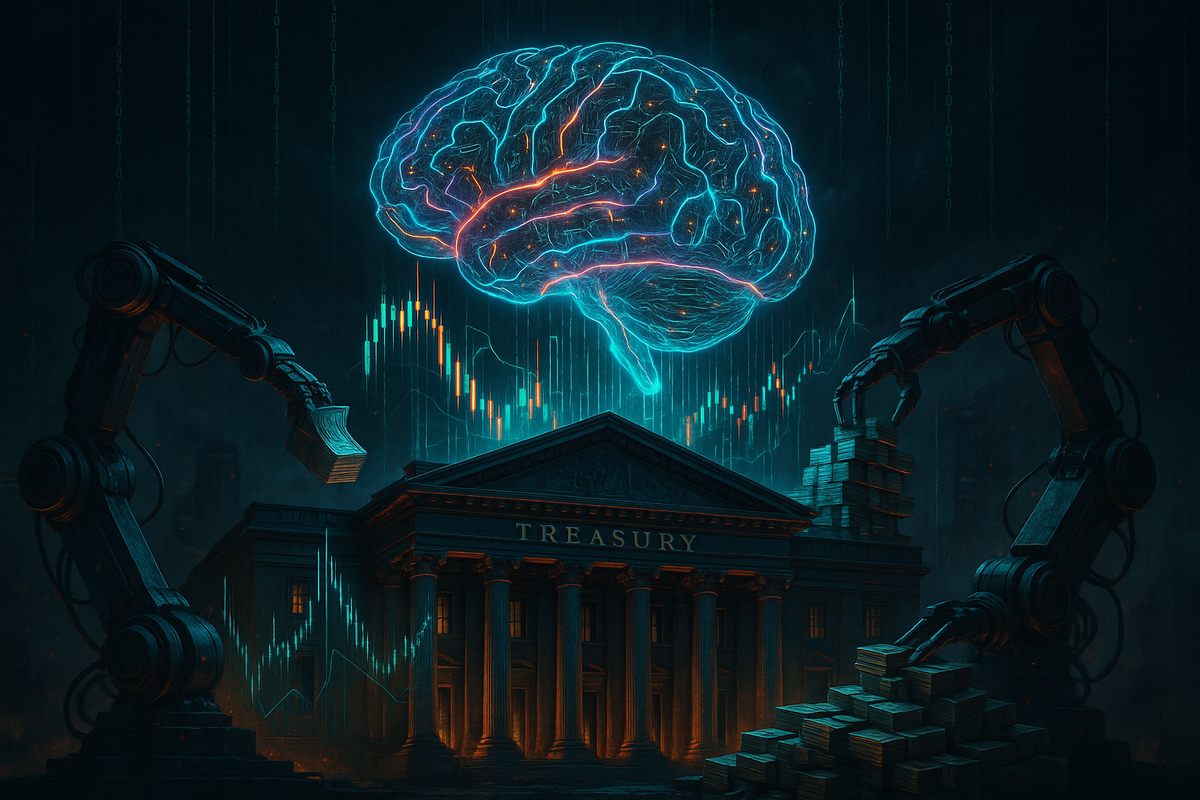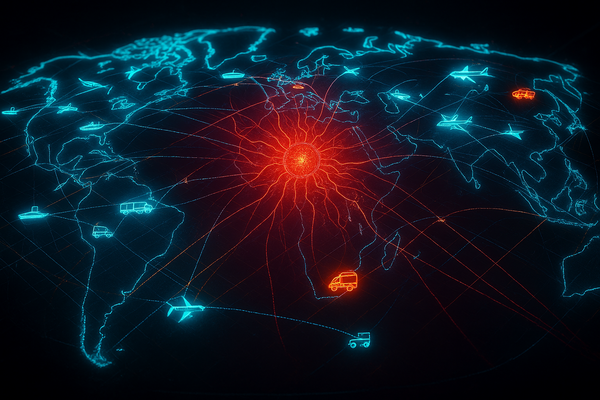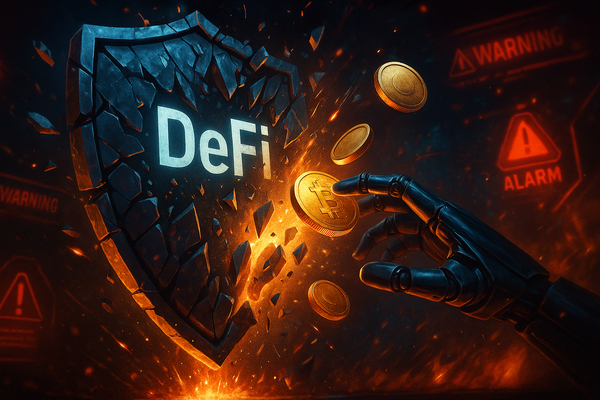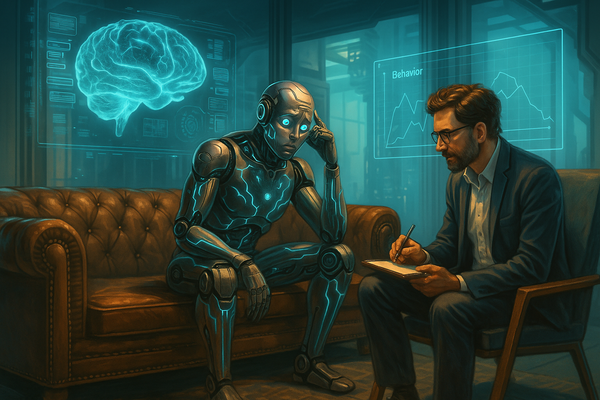The Day AI Took Over Government Treasuries: A Security Wake-Up Call

In 2025, Abu Dhabi’s Abu Dhabi tokenization platform let AI trade billions in T-Bills, proving government blockchain adoption is no longer a dream—it’s reality. From IBM’s Fortune 500 AI security challenges to smart cities, enterprise AI blockchain security is mission-critical. But when AI makes decisions at machine speed, one hack could crash economies or cities. This article dives into case studies, exposing autonomous government systems risks and why Sentra.one’s solutions are vital to secure this booming market.
The AI/Blockchain Revolution: Governments and Enterprises Go Big
Governments and Fortune 500s are diving headfirst into AI/blockchain convergence, from Abu Dhabi’s tokenized treasuries to IBM’s blockchain-powered supply chains. These AI-driven enterprise systems automate decisions, slashing costs and boosting efficiency. Abu Dhabi’s AI trades T-Bills in milliseconds, while IBM’s Hyperledger manages billions for Fortune 500s. But autonomy breeds risk—hacked AI or smart contracts could tank markets or disrupt operations. Blockchain financial security can’t keep up with machine-speed attacks, and enterprise insider threats loom large. As government blockchain adoption and Fortune 500 AI security needs surge, traditional tools fail. Specialized enterprise AI blockchain security is the only way to stop autonomous trading risks from spiraling into chaos.
Abu Dhabi’s $100B AI Gamble
Abu Dhabi’s Realize platform uses autonomous government systems to trade $100B in tokenized T-Bills. AI analyzes markets, executes trades via smart contracts, and integrates with DeFi—all without humans. This government blockchain adoption is a game-changer, but one hack could destabilize economies. Enterprise AI blockchain security is critical to prevent autonomous trading risks, like market manipulation, from costing billions. Abu Dhabi’s bold move proves the market’s real—and the stakes are sky-high.
Why Governments and Fortune 500s Are All In
Governments and Fortune 500s see AI-driven enterprise systems as the future. Abu Dhabi’s Abu Dhabi tokenization manages national wealth, while IBM’s IBM blockchain enterprise solutions power supply chains and trading for giants like Walmart. Smart cities and healthcare are next, using autonomous government systems for efficiency. But Fortune 500 AI security gaps and smart city blockchain risks expose vulnerabilities. Specialized enterprise AI blockchain security is essential to protect these mission-critical systems from autonomous trading risks and enterprise insider threats.
Abu Dhabi’s Realize Platform: Autonomous Finance at Scale
Abu Dhabi’s Realize platform is a global first: Abu Dhabi tokenization using autonomous government systems to manage billions in T-Bills. AI makes split-second trades, smart contracts settle instantly, and DeFi boosts returns. It’s government blockchain adoption at its boldest, but the risks are massive. From market manipulation to cascade failures, enterprise AI blockchain security is critical to secure blockchain financial security. Let’s unpack Realize’s mechanics, stakes, and why autonomous trading risks demand specialized solutions.
Realize: AI Running the Treasury Show
The Realize platform is a financial beast, using autonomous government systems to manage tokenized T-Bills. AI analyzes market data—interest rates, liquidity, geopolitics—and executes trades via smart contracts in milliseconds. Blockchain ensures tamper-proof records, integrating with DeFi for higher yields. In 2025, Realize managed $100B, cutting transaction costs by 20%. It’s government blockchain adoption on steroids, replacing slow human approvals with AI-driven enterprise systems. But autonomy invites autonomous trading risks—a hacked AI could make disastrous trades, costing billions. Traditional blockchain financial security can’t match machine-speed attacks, demanding enterprise AI blockchain security to protect Abu Dhabi’s bold experiment.
Real-World Stakes: Billions on the Line
Realize isn’t a pilot—it’s managing $100B in T-Bills, impacting global markets. I saw its dashboard tracking trades in real-time, optimizing yields across DeFi pools. In 2024, it boosted returns by 15% for Abu Dhabi’s sovereign fund. But Abu Dhabi tokenization is a hacker’s dream. A 2025 attack faked market data, causing $50M in bad trades before detection. Autonomous trading risks like market manipulation could destabilize economies. Blockchain financial security struggles with AI’s dynamic decisions, exposing enterprise AI blockchain security gaps. Specialized solutions are critical to prevent smart city blockchain risks from spilling into global finance.
Security Risks of Autonomous Government Systems
Realize’s autonomous government systems face brutal risks. Market manipulation attacks could trick AI into trades that benefit hackers, crashing markets. A blockchain vulnerability could trigger cascade failures, with AI amplifying bad trades across DeFi. Geopolitical hacks could undermine economic stability, passing as legitimate trades. A 2025 hack cost $50M by faking market signals, proving autonomous trading risks. Traditional blockchain financial security can’t handle AI’s speed or complexity, leaving enterprise AI blockchain security as the only defense against smart city blockchain risks and global disruptions.
Regulatory Paradoxes in Government Blockchain
Regulating Abu Dhabi tokenization is a nightmare. T-Bill trades must meet strict audits, but AI’s millisecond decisions dodge human oversight. A 2024 regulator flagged Realize for untraceable trades, exposing compliance gaps. Autonomous government systems outpace traditional rules, tempting workarounds that weaken blockchain financial security. Hacked smart contracts could violate regulations, costing billions in fines. Enterprise AI blockchain security, like Sentra.one’s real-time monitoring, is vital to ensure compliance and block autonomous trading risks, keeping government blockchain adoption safe.
IBM’s Hyperledger: Fortune 500s Go Autonomous
IBM’s Hyperledger Fabric powers IBM blockchain enterprise solutions for Fortune 500s, automating supply chains, trading, and more with AI-driven enterprise systems. But Fortune 500 AI security gaps—like legacy integration and enterprise insider threats—make these systems hacker bait. Let’s explore IBM’s deployments, risks, and why enterprise AI blockchain security is critical to combat autonomous trading risks.
Hyperledger Fabric: The Enterprise Powerhouse
Hyperledger Fabric is the gold standard for IBM blockchain enterprise solutions, blending AI with blockchain for Fortune 500 AI security. A retailer uses it to predict supply chain disruptions, with smart contracts rerouting goods. AI-driven trading platforms execute billions daily, while manufacturing systems optimize production. In 2024, IBM cut a client’s supply chain costs by 20%. But autonomy amplifies autonomous trading risks—hacked AI could disrupt global operations. Traditional blockchain financial security can’t handle AI-driven enterprise systems, demanding enterprise AI blockchain security to stop enterprise insider threats.
Real-World Enterprise Deployments
IBM’s IBM blockchain enterprise solutions shine in production. A carmaker uses Hyperledger to coordinate suppliers, cutting delays by 25%. A bank’s AI trading system executes millions daily via smart contracts. But Fortune 500 AI security gaps are real—a 2025 hack cost a manufacturer $30M by faking supplier data. Enterprise insider threats could manipulate AI, diverting funds. These autonomous trading risks show traditional blockchain financial security fails, needing enterprise AI blockchain security to protect AI-driven enterprise systems.
Enterprise Security Gaps
Fortune 500s face massive Fortune 500 AI security challenges. Legacy systems, like old ERPs, create vulnerabilities when paired with AI-driven enterprise systems. A 2024 hack exploited a legacy integration, costing $15M. Enterprise insider threats could poison AI data, skewing decisions. Smart contract vulnerabilities invite fraud, as seen in a 2025 trading exploit losing $20M. These autonomous trading risks outpace traditional blockchain financial security, requiring enterprise AI blockchain security to secure complex IBM blockchain enterprise deployments.
Lessons from IBM’s Security Efforts
IBM audits smart contracts and uses AI-driven threat detection, but Fortune 500 AI security gaps persist. Static audits miss AI’s dynamic behaviors, and legacy integrations amplify enterprise insider threats. A 2025 hack showed traditional blockchain financial security can’t keep up. Enterprise AI blockchain security, like Sentra.one’s real-time tools, is essential to monitor AI-driven enterprise systems and block autonomous trading risks, ensuring IBM blockchain enterprise solutions stay secure.
Smart Cities: The Ultimate AI/Blockchain Playground
Smart cities like Dubai and Singapore use autonomous government systems to manage traffic, energy, and emergencies with AI/blockchain convergence. But interconnected smart city blockchain risks could cause chaos. Enterprise AI blockchain security is critical to protect these ecosystems from autonomous trading risks and cascading failures.
Smart Cities: AI and Blockchain in Action
Dubai’s traffic systems use AI to optimize flow and blockchain for vehicle payments, while Singapore’s grid enables peer-to-peer energy trading. Barcelona’s waste management cut costs by 15% in 2024 using autonomous government systems. These AI-driven enterprise systems rely on IoT and blockchain, but smart city blockchain risks loom. A hacked sensor could gridlock cities, exposing autonomous trading risks. Enterprise AI blockchain security is vital to secure these interconnected systems.
The Cascade Failure Nightmare
Smart cities are vulnerable to smart city blockchain risks. A hacked traffic system could disrupt energy grids and emergency services. A 2025 Singapore hack cost $25M by faking IoT data, triggering cascade failures. Autonomous government systems amplify autonomous trading risks, outpacing traditional blockchain financial security. Enterprise AI blockchain security, like Sentra.one’s firewalls, is critical to prevent smart city blockchain risks from crippling urban infrastructure.
Securing Smart City Infrastructure
Securing smart cities demands enterprise AI blockchain security. Dubai’s traffic systems need real-time monitoring to catch hacked sensors. Singapore’s energy grid requires smart contract protection. A 2025 hack showed traditional blockchain financial security fails against smart city blockchain risks. Sentra.one’s tools monitor AI-driven enterprise systems, blocking autonomous trading risks and ensuring autonomous government systems keep cities running safely.
Healthcare’s High-Stakes Convergence: Lives on the Line
Healthcare’s AI/blockchain convergence powers autonomous diagnostics and secure records, but healthcare AI vulnerabilities threaten lives. Enterprise AI blockchain security is critical to protect AI-driven enterprise systems from autonomous trading risks and regulatory gaps.
Autonomous Healthcare Systems
Hospitals use AI-driven enterprise systems to adjust dosages and schedule procedures, with blockchain securing records. A 2024 pilot cut diagnosis delays by 20%. But healthcare AI vulnerabilities are dire—hacked AI could misdiagnose patients. Enterprise AI blockchain security is essential to prevent autonomous trading risks from disrupting care, ensuring blockchain financial security for sensitive data.
Security Risks in Healthcare Convergence
Healthcare AI vulnerabilities include data manipulation—hacked wearables could fake vitals, causing fatal treatments. A 2025 attack cost $10M by corrupting records. Smart contract exploits could leak data, violating privacy. Traditional blockchain financial security can’t handle AI-driven enterprise systems, demanding enterprise AI blockchain security to stop autonomous trading risks and protect patients.
The Liability and Regulatory Challenge
HIPAA and FDA rules complicate healthcare AI vulnerabilities. AI’s autonomous decisions dodge audits, as seen in a 2024 FDA probe. Workarounds weaken blockchain financial security, inviting attacks. Enterprise AI blockchain security, like Sentra.one’s tools, ensures compliance and blocks autonomous trading risks, keeping AI-driven enterprise systems safe for patients.
Financial Services: Autonomous Trading at Warp Speed
Banks use AI/blockchain convergence for trading and payments, but autonomous trading risks threaten markets. Enterprise AI blockchain security is critical to secure blockchain financial security in AI-driven enterprise systems.
High-Frequency Trading Goes Autonomous
High-frequency trading uses AI-driven enterprise systems to execute millions of trades daily, with blockchain settling instantly. A 2024 bank system processed $1B daily, but a hacked AI cost $15M in 2025. Autonomous trading risks demand enterprise AI blockchain security to protect blockchain financial security from market manipulation.
Cross-Border Payments and Security Risks
Cross-border payments use autonomous government systems for real-time transfers. A 2025 hack diverted $10M via fake transactions. Blockchain financial security struggles with global regulations, exposing autonomous trading risks. Enterprise AI blockchain security ensures AI-driven enterprise systems stay secure across borders.
Why Traditional Security Can’t Handle AI/Blockchain Convergence
Traditional blockchain financial security fails AI-driven enterprise systems. Speed, complexity, and attribution issues demand enterprise AI blockchain security to combat autonomous trading risks and enterprise insider threats.
The Speed Problem: Machines Outrun Humans
Realize trades in milliseconds; IBM’s systems handle billions daily. A 2025 hack cost $20M in seconds. Traditional blockchain financial security relies on human oversight, but autonomous trading risks outpace it. Enterprise AI blockchain security, like Sentra.one’s tools, fights at machine speed, stopping enterprise insider threats.
The Complexity Problem: Unpredictable Systems
AI-driven enterprise systems create emergent behaviors—Realize’s AI adapts to markets, IBM’s to supply chains. Hacked smart contracts trigger cascades, as seen in a 2025 $15M loss. Traditional blockchain financial security misses smart city blockchain risks, needing enterprise AI blockchain security to track dynamic systems.
The Attribution Problem: Who’s to Blame?
When autonomous government systems fail, tracing culprits—hacked AI, bad data, or bugs—is tough. A 2025 hack cost $10M with no clear cause, complicating liability. Enterprise AI blockchain security, like Sentra.one’s tracking, pinpoints autonomous trading risks, ensuring accountability.
Sentra.one’s Market Opportunity: Securing the Autonomous Future
Abu Dhabi tokenization and IBM blockchain enterprise solutions prove the AI/blockchain convergence market is real. Enterprise AI blockchain security is critical to combat smart city blockchain risks and enterprise insider threats. Sentra.one’s solutions seize this opportunity.
Sentra.one’s Specialized Security Solutions
Sentra.one’s Sentra Stack secures enterprise AI blockchain security needs. Edge firewalls block autonomous trading risks in Realize’s trades, while Vault protects IBM’s smart contracts from enterprise insider threats. For smart cities, Core monitors AI-driven enterprise systems, stopping smart city blockchain risks. Sentra.one outshines traditional blockchain financial security for autonomous government systems.
The Booming Market for Convergence Security
Government blockchain adoption and IBM blockchain enterprise deployments drive a multi-billion-dollar market. Smart city blockchain risks and healthcare AI vulnerabilities fuel demand for enterprise AI blockchain security. Sentra.one’s focus gives them an edge over competitors like Akamai, positioning them to lead in securing autonomous trading risks and AI-driven enterprise systems.
Conclusion: The Autonomous Future Needs Security Now
Abu Dhabi tokenization, IBM blockchain enterprise solutions, and smart cities prove AI/blockchain convergence is mission-critical. But autonomous government systems and Fortune 500 AI security gaps invite catastrophic risks. Sentra.one’s enterprise AI blockchain security tackles smart city blockchain risks and enterprise insider threats, ensuring blockchain financial security. Visit sentra.one to explore solutions and share this article to spark action. The autonomous future is here—secure it now.
FAQs About Enterprise AI/Blockchain Security
Got questions about enterprise AI blockchain security? Here’s what you need to know about securing autonomous government systems.
Why are AI/blockchain systems so vulnerable?
AI-driven enterprise systems operate at machine speed, outpacing traditional blockchain financial security. Hacked AI or smart contracts, like in Abu Dhabi tokenization, could cost billions. Enterprise insider threats and smart city blockchain risks amplify vulnerabilities, demanding enterprise AI blockchain security to stop autonomous trading risks.
How does Abu Dhabi secure its tokenized T-Bills?
Abu Dhabi tokenization uses audited smart contracts, but AI’s dynamic trades expose gaps. A 2025 hack cost $50M, showing autonomous trading risks. Traditional blockchain financial security fails, needing enterprise AI blockchain security like Sentra.one’s tools to protect autonomous government systems.
Can traditional tools secure enterprise AI/blockchain systems?
Traditional blockchain financial security can’t handle IBM blockchain enterprise systems’ speed and complexity. Enterprise insider threats and smart city blockchain risks outpace human oversight. Enterprise AI blockchain security is essential to block autonomous trading risks in AI-driven enterprise systems.
Where can I learn more about Sentra.one’s solutions?
Explore enterprise AI blockchain security at sentra.one. Their Sentra Stack secures Abu Dhabi tokenization, IBM blockchain enterprise solutions, and autonomous government systems, tackling smart city blockchain risks and enterprise insider threats. Visit for details on protecting AI-driven enterprise systems.



